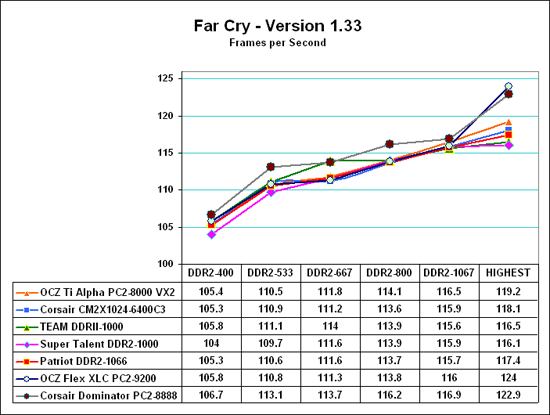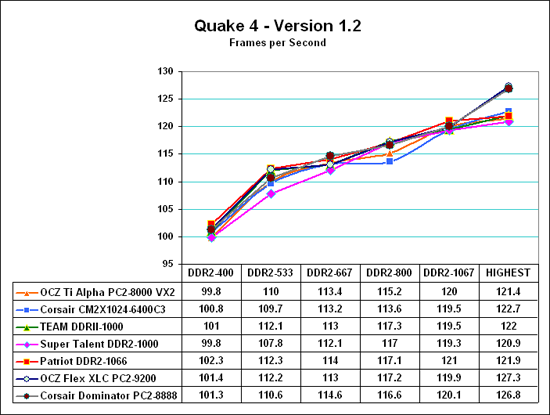Corsair Dominator DDR2-1111: Dual-Path Cooling Pushes Performance
by Wesley Fink on January 1, 2007 5:15 AM EST- Posted in
- Memory
Game Performance Comparison
Real-world benchmarks - specifically gaming benchmarks - provide the most useful measure of memory performance if you keep in mind what they represent. Memory is just one small part of overall gaming performance, and the AnandTech benchmarks keep everything the same except memory speed. Even the CPU speed is kept constant except in the overclocking tests. As a result performance improvements in FPS are very small because the only factor influencing the test results is memory speed. Many factors affect system performance, and memory speed is just one of those factors.
Results for high-end memory were very close at tested speeds. Therefore, the scale range was reduced to better show the small differences in these memory benchmark results at each speed. Please keep this in mind when viewing the charts. A normal zero scale would make performance differences appear much smaller than these expanded scale charts. Test values for each memory at each speed are included below each chart for reference.
The AT memory test suite uses Far Cry, Half Life 2 and Quake 4 for memory testing because they are sensitive to memory performance.



Despite the fact that memory is varying from 3-2-2-6 timings at DDR2-400 all the way to 5-5-5-18 timings at DDR2-1067 all three games continue to show improvement in frame rates as memory speed increases. Put another way, performance continues to improve as memory speed increases. This is the best evidence you will find to prove that increasing memory speed does increase performance - even to DDR2-1067 and beyond. Corsair Dominator again mirrored performance of the other Micron-based memory until we reached the top speed. More often than not it registered the highest test results, but the differences in performance at stock speeds are very small. Above DDR2-1067 Dominator broke away from the pack, producing the highest game test results we have seen so far at any overclocked speeds. This is no doubt the result of the tighter 4-4-4 timings that could be maintained all the way to DDR2-1233. Corsair Dominator set new performance records in every test category, and it managed to just edge the also fast OCZ Flex XLC in most gaming benchmarks.
Real-world benchmarks - specifically gaming benchmarks - provide the most useful measure of memory performance if you keep in mind what they represent. Memory is just one small part of overall gaming performance, and the AnandTech benchmarks keep everything the same except memory speed. Even the CPU speed is kept constant except in the overclocking tests. As a result performance improvements in FPS are very small because the only factor influencing the test results is memory speed. Many factors affect system performance, and memory speed is just one of those factors.
Results for high-end memory were very close at tested speeds. Therefore, the scale range was reduced to better show the small differences in these memory benchmark results at each speed. Please keep this in mind when viewing the charts. A normal zero scale would make performance differences appear much smaller than these expanded scale charts. Test values for each memory at each speed are included below each chart for reference.
The AT memory test suite uses Far Cry, Half Life 2 and Quake 4 for memory testing because they are sensitive to memory performance.



Despite the fact that memory is varying from 3-2-2-6 timings at DDR2-400 all the way to 5-5-5-18 timings at DDR2-1067 all three games continue to show improvement in frame rates as memory speed increases. Put another way, performance continues to improve as memory speed increases. This is the best evidence you will find to prove that increasing memory speed does increase performance - even to DDR2-1067 and beyond. Corsair Dominator again mirrored performance of the other Micron-based memory until we reached the top speed. More often than not it registered the highest test results, but the differences in performance at stock speeds are very small. Above DDR2-1067 Dominator broke away from the pack, producing the highest game test results we have seen so far at any overclocked speeds. This is no doubt the result of the tighter 4-4-4 timings that could be maintained all the way to DDR2-1233. Corsair Dominator set new performance records in every test category, and it managed to just edge the also fast OCZ Flex XLC in most gaming benchmarks.










14 Comments
View All Comments
classy - Monday, January 1, 2007 - link
It won't be on memory that gives me an extra 2-5 frames. While it performs well, it just doesn't make enough of a performance impact to warrant the price. Maybe for a dream system but for the other 99.75% of the pc world this memory is clearly a waste of money.code255 - Sunday, January 7, 2007 - link
Totally agree. Buying super high quality memory is an utter waste of money. Double the cost of normal RAM for like 1% higher framerates? Thanks, but no f***ing thanks!I usually buy value RAM from decent manufacturers (which is more expensive than from no-name brands) just for the sake of stability. RAM just doesn't have a significant enough impact on gaming performance to justify the insane prices of the top-of-the-line stuff.
tayhimself - Tuesday, January 2, 2007 - link
This is such another example of reviews driven by ridiculous marketing than by product reviews that may be worthwhile or beneficial to 99% of readers. I don't doubt there are people spending $600 on 2 GB of DDR2 to get that extra 1.5% performance boost, I just doubt there are very many of them.A review of value RAM sticks on 965, 975x, or 590 chipsets would be far more useful and informative because of ridiculous compatibility issues with mobos. But alas these reviews rarely happen...
bigboxes - Monday, January 1, 2007 - link
It's nice to see Corsair finally getting back into the game. Here's to prices dropping, though it may be a while. :)